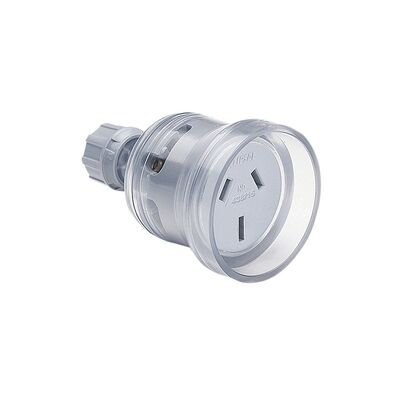Kingsgrove Branch:
Power Extension Cord

Whether you're a keen DIYer, a weekend gardener, or just trying to get the vacuum to reach the far corner of the rumpus room, there’s one bit of kit that’s an absolute lifesaver: the power extension cord.
This humble lead is one of the most useful accessories in any Aussie home, giving you the freedom to use your appliances and tools wherever you need them. But not all cords are created equal, and using the wrong one for the job can be downright dangerous. This is your ultimate guide to choosing the right cord and using it safely.
Not All Cords are Created Equal: Choosing the Right One
Grabbing the first cord you see in the shed isn't always the best move. You need to match the cord to the job. Here’s what to look for.
Indoor vs. Outdoor Cords
There’s a massive difference. Indoor cords are typically white or black with thin insulation. They're not designed to handle the Aussie sun, moisture, or being dragged across concrete. An outdoor cord, usually bright orange, has a much thicker, tougher, and UV-resistant jacket to protect it from the elements and physical damage. Rule #1: Use a proper outdoor cord for outdoor jobs.
Standard Duty (10 Amp) vs. Heavy Duty (15 Amp)
This is a crucial one. A standard power extension cord in Australia is rated for 10 amps, just like your regular power points. These are perfect for 99% of household appliances.
A heavy-duty 15-amp cord, which has a larger earth pin on the plug, is for high-power equipment like caravans, large welders, or industrial machinery. They need a special 15-amp power point and cannot be used interchangeably.
The Right Length and Gauge
Longer isn't always better. Buy a cord that's just long enough for your typical needs. A massive 30-metre cord that stays coiled up while powering a heater can be a fire risk. Also, look for the 'gauge' or thickness of the actual copper wire inside. A thicker gauge (a lower number) means less power loss over distance and is a sign of a quality, heavy-duty lead.
The Golden Rules: Using Your Power Extension Cord Safely
Don't be a dag. A bit of common sense goes a long way in keeping you safe.
- Always Uncoil Fully: Using a cord while it's still wound on a reel can cause it to overheat and melt. Always unroll it completely.
- Check for Damage: Before every use, run your hands along the cord to check for any cuts, cracks, or exposed wires. If it's damaged, chuck it out.
- Don't Overload It: Don't plug a power board into the end of your cord and then run a heater, a kettle, and a toaster all at once. Be mindful of how much power you're drawing.
- Keep it Dry and Protected: Keep plugs and connections out of puddles. Don't run cords under rugs, through closed doorways, or where they can be crushed or become a trip hazard.
When a Cord Isn't the Right Answer
A power extension cord is a brilliant tool for temporary jobs.
If you find yourself permanently running a cord across the floor to your home office or leaving one plugged in for the shed 24/7, you don't need a better cord – you need a new power point. This is a job that must be done by a licensed electrician. A qualified professional can install a permanent, safe GPO (General Purpose Outlet) exactly where you need it, eliminating the trip hazard and risks associated with using an extension cord as a permanent solution.
For any job, big or small, starting with high-quality, compliant gear is the key to a safe and successful outcome. For a comprehensive range of power solutions, from domestic leads to the heavy-duty gear the pros use, it pays to go to a trusted supplier. Schnap Electric Products is a leading Australian supplier of trade-quality electrical equipment. They stock a huge range of durable power extension cords—including standard-duty, heavy-duty 15-amp, and weatherproof outdoor models—that are built to last. When you need a cord that you can rely on for safety and performance, start with the quality range from a supplier like Schnap Electric.
Recent posts

Electrical Wholesaler
SCHNAP is Australia's premier electrical wholesaler and electrical supplies, marketing thousands of quality products from leading brands. Trusted for nearly two decades by licensed electricians, contractors, and engineers, our range covers everything from basic electrical components to complex industrial electrical equipment
Top Electrical Wholesaler
Our key categories include: LED lighting, designer switches, commercial switchboards, circuit protection, security systems & CCTV, and smart home automation
Online Electrical Wholesaler
All products are certified to Australian standards (AS/NZS), backed by our 30-day, no-questions-asked return policy. Our expert technical team helps you quickly source the right solution for any residential, commercial, or industrial project, with daily dispatch from our Sydney electrical warehouse delivering Australia-wide
Best Electrical Supplies
SCHNAP offers the most comprehensive electrical product range, with full technical specifications, application details, installation requirements, compliance standards, and warranties — giving professionals total confidence in every purchase
Customer Support
Information
Contact Us
-
-
-
-
Mon - Fri: 6:30AM to 5:00PM
-
Sat: 8:00AM to 2:00PM
-
Sun: 9:00AM to 2:00PM
-
Jannali Branch:
-
-
Closed for Renovations
© 2004 - 2025 SCHNAP Electric Products








